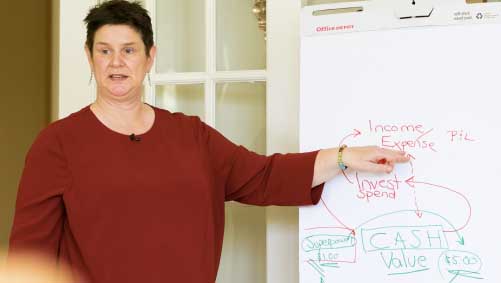
BLOG 2: PART TWO OF BALANCE SHEET SERIES
Welcome back to Part II of our blog post on the Balance Sheet – the business owner’s true keys to the kingdom. Just as surely as losing your bank password, social security number, or credit card security code can steal you blind, so can an unmanaged Balance Sheet.
So, congrats on coming back for Part II. Part I wasn’t so bad – only one hour of your time twice a year.
This Part II is optional, but this short read will up your game on understanding what’s on that Balance Sheet and how it can help or hurt you. This will really come in handy if you ever decide to sell your business, because you can be sure it’s the stuff any buyer is going to want to understand completely.
SHORT VERSION: It’s called a Balance Sheet because it is a balanced equation:
Assets = Liabilities + Equity
In plain English that means:
What I Own = How I Paid for It
Everything you own is an Asset; and the way you’ve funded your business is one of these ways:
- Borrowing (Liabilities) PLUS
- Putting money in yourself (Equity) through
- Cash you put in the business bank account
- Money you’ve earned in the business
Typical Assets (Stuff you OWN)
Your assets are going to be your bank accounts, your inventory, the amounts that customers still owe you (known as Accounts Receivable), and your big stuff like equipment and furniture.
Here’s how you make sure those numbers are right:
- Cash – this amount should match your bank statement or your bookkeeper should be able to explain the difference in a way that makes sense to you (they should be keeping a monthly reconciliation – see Part I of this blog post for more detail)
- Accounts Receivable – there’s a report called Accounts Receivable Aging that shows you how much money each of your customers still hasn’t paid you and how long they’ve owed you that money
- Inventory – this is the product you have purchased but haven’t sold yet. Someone should be pretty sure that the number here pretty accurately represents how much product is still in your warehouse or back room
- Fixed Assets – this is a weird one because there’s this depreciation thing that happens. But it’s okay to just be sure that you’re comfortable that whatever number is there really does look about like the amount you’ve spent on “big stuff” – equipment, furniture, expensive computers.
- Pro Tip: Your bookkeeper should get information from you to create what’s called an “Fixed Asset List” that shows when you bought each thing, who you bought it from, and how much you paid for it.
Typical Liabilities (Stuff you OWE)
You may have both short- and long-term liabilities. Nothing fancy here – short-term is what you owe people and need to pay within the next twelve months; and long-term is stuff you don’t have to pay for at least a year.
Short-term liabilities are things like credit card balances, and what you owe your vendors, suppliers, contractors, employees, and the tax man.
Long-term liabilities are usually longer-term bank loans.
The short-term liabilities are often called “Payables” because it’s money we have to pay people. Here are the main categories and how to think about them and check on them:
- Accounts Payable – Since this is money you owe people, there is a report called Accounts Payable Aging that will list out each person you owe money to, how much you owe them, and how long you’ve owed it to them. Take a look at this monthly to be sure you know everyone on it, and that it makes sense that you owe them the amounts that are there
- Credit Card Accounts – this amount should match your credit card statement or your bookkeeper should be able to explain the difference in a way that makes sense to you (they should be keeping a monthly reconciliation – see Part I of this blog post for more detail)
- “Other” Payables – (e.g., Salaries Payable, Sales Tax Payable, Payroll Tax Payable) – these are a little more complicated, but your bookkeeper should be able to tell you why you owe the amount that the Balance Sheet says you owe.
- Long-term Loans — These are straightforward; you know what loans you have and how long you’ve been paying them. These should be verified by comparing to a statement from the lender at least quarterly. That way you know that your expectations are the same as theirs.
- Pro Tip: A common mistake that is made by home-grown bookkeepers who may not have a full understanding of accounting is that they don’t properly separate interest and principal when they book your payments. Make sure, if you have an interest-bearing loan, that you see interest expense on your Profit and Loss Statement.
Equity (Stuff You’ve Contributed and Earned)
Equity is the money you’ve (1) put into the business plus (2) the money you’ve earned in the business (i.e., your Net Income since the beginning of time).
That’s it! You now know more about your balance sheet and why it is important to you as a business owner than most entrepreneurs out there. As the questions of your bookkeeper from Part I; and review your balance sheet monthly to be sure you are always aware of what’s on it.
And sure, those two things put you in great shape if you ever need a loan or want to sell your business. But in the meantime, it will protect you from both fraud and from making important decisions based on faulty information.





